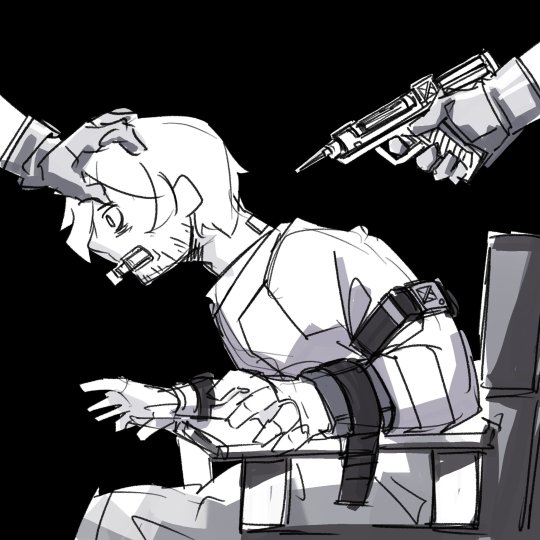Text
whumpee is captured and held for some time---but eventually, they're rescued, with whumper having fled. whumpee seems mostly unharmed, and tells only a story of simple imprisonment, not having been particularly mistreated. this surprises team---but, hey, it's not necessarily a bad thing, right? even if it doesn't align with how whumper seems to function? eventually, team moves on, just glad to be reunited.
until they confront whumper again as a team. whumpee seems normal---until whumper just says the word, and whumpee immediately starts attacking their friends like a vicious feral animal. that's essentially what they are now; an animal, made to do whatever whumper orders them to, never to disobey.
even if that order is to "blend in".
335 notes
·
View notes
Text
Pulling Off In Medias Res
In medias res refers to the act of starting a story "in the middle" of the narrative, usually during a dramatic or unusual moment, and writing the background and context for these events after the fact, either as exposition or flashbacks, making this mode of storytelling non-linear. This contrasts a typical story structure which usually follows the clear harmony->disharmony buildup, where characters start in their ordinary environment, ie. 'Once upon a time...'
There are many benefits to starting your story in medias res. The most obvious of these benefits is that, if executed well, your readers will immediately be hooked on the action, and will naturally begin to ask questions about why your characters are in the situation they're in - which in turn will make them look forward to exposition, rather than finding it tedious. It will also make you, as the writer, more efficient at getting to the meat of your story, without being bogged down by inconsequential details - this is a great tool if you have trouble getting your story started.
You can write in medias res in a lot of different ways:
Starting with an action scene (a fight, a chase, etc)
Starting with a scene in which a central character is in a high-stakes dilemma (trolley problem, witnessing a murder and debating whether to risk their own safety to report it, etc)
Starting with a central character otherwise making some sort of tough decision (breaking up with someone, betraying or letting down a friend, etc)
Starting with a central character doing something unusual or otherwise questionable, which makes readers curious (waking up in a ditch, digging a suspicious grave-sized hole in the dead of night, etc)
Starting in the immediate aftermath of the inciting incident, or some other pivotal event (at the funeral of someone important to a central character, arriving by the crater where the alien spaceship just crashlanded, etc.)
Or a mix of any of these
Know the pitfalls
In medias res comes with a couple drawbacks that you have to be aware of as a writer.
The first of these is that you have to know your plot very well in order to balance action or drama with an appropriate amount of exposition, for reasons I will get into in a bit.
The second is that when starting in medias res, your readers will not have had time to build a strong emotional connection to your characters, and thus the scene might not feel as significant and pivotal to them as it does to you. For this reason, I would not recommend starting your story with something like the death of a central character - unless you're confident in your ability to effectively establish that emotional connection after the fact.
The third is that readers typically interpret the opening scene as indicative of the story as a whole, so because in medias res is typically high-pace and high-tension, they will assume that this applies to the story as a whole. If your story is more of a slow-building, drawn-out-rising-action sort of thing, you can still use in medias res as the initial hook - many writers do - but you need to pay extra careful attention to how your opening scene might affect your reader's expectation of the overall pace of your story. (Ex. a way to do this is to use in medias res with an extremely high pace and then kind of whiplash back to the slow pace that is the starting point from which you build your rising action. This alone can be a point of intrigue in your readers - the presence of that high-stakes opener serves as a reminder that builds tension through the slow parts all on its own. But it has to be a conscious choice on your part.)
Finding the sweet spot
Writing in medias res well is a balancing act of a few different key elements. The most obvious one of these is the balance between action and exposition. If you fill your starting scene with too much exposition, you will suck the curiosity out of your readers and break the pace of your scene. If you reveal too little, however, your readers will not be able to understand what's going on. In my opinion, as a key rule for your starting scene, the less exposition, the better - fixing reader confusion is a lot easier than fixing pacing issues. Keeping that in mind, here are some ways to make the scene easier for your new readers to follow:
Write the scene with as few characters as possible, ideally sticking to only two or three characters. The less names your reader has to keep track of, the better.
Keep the scene itself simple. Some scenes require a lot of different things to happen at once, and scenes like that can work wonderfully and be enthralling if you know the background and characters well - which your readers, having just arrived here, do not. Thing happens -> character reacts -> character makes a decision. That kind of vibe.
Keep descriptions brief and simple. If your universe has a complicated magic system, an in medias res action scene is typically not the best place to learn all its intricacies. I'm exaggerating a bit, but my point is this: If your starting scene requires detailed lore for comprehension, it might not be a good idea to start with that scene.
A second balance to keep in mind as you construct your scene is that of intrigue and identification. In order to properly hook the reader in, the action has to feel significant, and since you're starting in the middle of things, you have to establish that significance very, very quickly. This can be done effectively by simply conveying a drive in your character which your readers can identify with, is otherwise intrigued by and curious about, or - if you want to really make a good hook - both. This drive can take the form of a goal, a motivation, a fear, or something similar. The drive is emphasised by narrowing the focus of your character, to the exclusion of anything that isn't directly relevant to their drives.
Intrigue: Your starting scene uncovers the heart of a mystery or problem, leaving your readers curious, interested, or fascinated about the plot or world.
Identification: Your starting scene establishes a point of connection between your reader and your characters, leaving your readers captivated, immersed, and emotionally invested in the characters.
Intrigue and identification: Your starting scene establishes a mystery and an emotional connection, leaving your readers invested in how the plot or world might impact your characters, and vice versa.
The most important rule of in medias res is that the scene you start with should be crucial to your plot. Starting with a bank robbery is exciting and draws attention, but it will feel like a cheap trick to your reader in retrospect if the characters involved or the bank robbery itself has no bearing on the rest of your story.
Following the opening scene
Like I said in the beginning, in medias res often comes with the added benefit of leaving your readers hungry for exposition, but that doesn't mean that you're now free to infodump to your heart's content. You're still in the beginning stages of your story, and good pacing is still vital to keep your new readers' attention. Meanwhile, you also need to start answering questions, specifically about the course of events or other backstory that proceeded the opening scene. This is ideally done strategically, slowly and organically, drip-feeding readers following the rising action of your first act - or, if you're writing a mystery, key elements might not be revealed until the climax of your story.
Backstory can be revealed in a lot of different ways, and there's no right or wrong way to do it - it all depends on what you feel is appropriate for the story you want to tell. Here are some common ways to reveal exposition:
Flashbacks. Many readers find flashbacks tedious or cliché, but I happen to like them a lot - it's all in the execution, baby. If you intend to use flashbacks, make sure they fit into the overall pace of your story, and keep in mind that readers are interested in your story's present, so flashbacks need to be significant to both your plot and your characters.
Dialogue between characters. This can be done well, but comes with the risk of inorganic, awkward-sounding dialogue, in which characters discuss events which both participated in, solely for the reader's benefit (ex. "Why did you break my vase? You know it's the only heirloom I have left after those bandits raided our village!")
Frame narrative, or a 'narrative within a narrative', is sort of a mix of exposition through dialogue and a flashback. This is when one character tells another, listening character, a story or sequence of events leading up to a particular event. This is hard to pull off without breaking pace or coming across as infodumping, so you need to time it well.
Internal monologue. This is a widespread way of revealing backstory, but it comes with similar risks to those associated with writing exposition through dialogue. Your character's internal monologue has to feel like the natural progression of their thoughts, and not like a convenient way of hamfisting in information.
Conclusion
In medias res saved my marriage and watered my houseplants, no cap, 100% 🔥🔥🔥
14 notes
·
View notes
Text

day 3: unnecessarily complex fit
first of all i know i'm late it's FINE
second i hate clothes with a burning passion i burnt out on this the second i started the pants lmao
1 note
·
View note
Text
i see your crawling tropes and i raise you: leader whumpees crawling.
the strongest one, the untouchable one, stumbling to the ground. one hand outstretched, reaching for a weapon to defend themselves; the object they're protecting; a phone to warn their team to be alert, that they're being taken, they can't protect anyone, nobody is safe anymore. the unbreakable leader, ruined to the point where they can't lift their battered body from the ground.
468 notes
·
View notes
Text
why is it always the fancylad boy-king type whos the bottom. maybe his tough loyal knight who uses his body to protect and defend him and lives to serve him wants to get railed
90K notes
·
View notes
Text
day 2: self insert
presented exactly as it would be in my high school notebooks
i forgot how much i hate this style
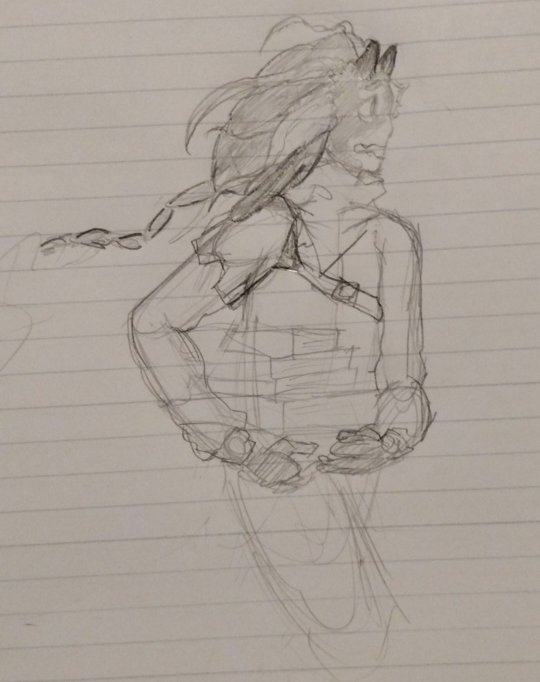
1 note
·
View note
Text
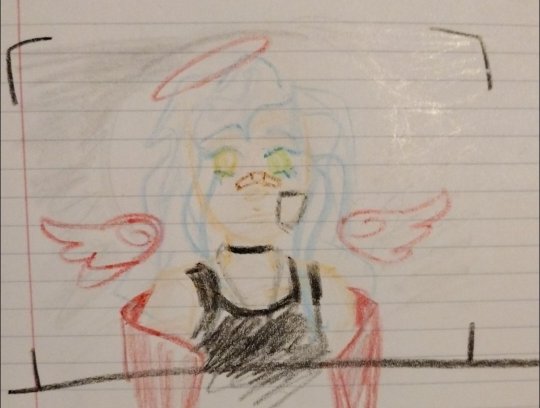
day one: heterochromia
i was gonna redraw this bc i'm unhappy with a lot of it but then middle school dan came back to slap me in the face so here is uhhhh
this
2 notes
·
View notes
Text
man fuck it we're putting cringetober over here
1 note
·
View note
Text
Being knocked out for more than 5 minutes means very serious brain damage but humans not having a turn-off button would do immense damage to our collective storytelling. So many films and books and videogames just wouldn't happen if writers stopped bonking their characters on the head. Insane.
32K notes
·
View notes
Photo
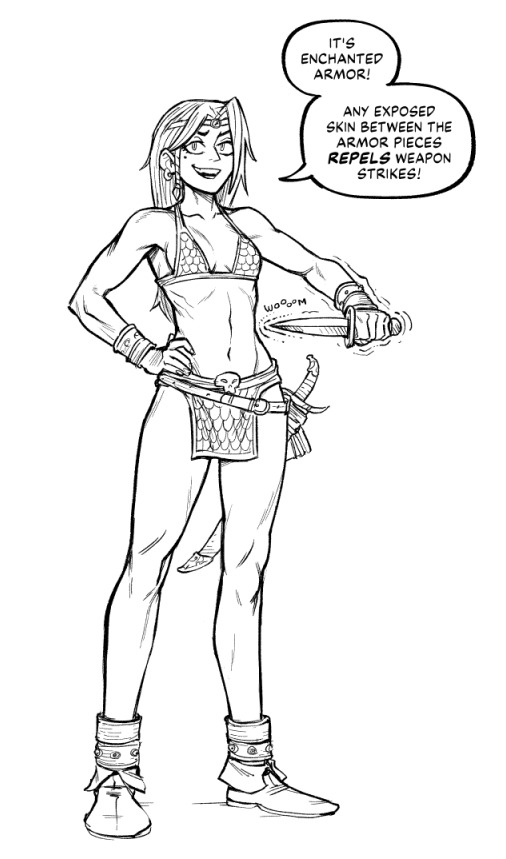

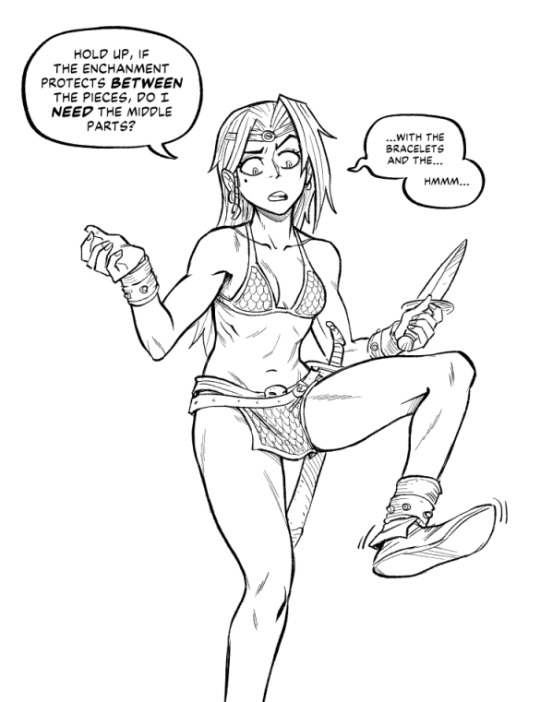

I have discovered the truth about chainmail bikinis, and it is imperative those wearing such armor do not think about it too hard or they may inadvertently cross the line between Sexy Hero and Homicidal Pervert.
171K notes
·
View notes
Text
NEW WHUMP IDEA‼️‼️
Whumpee was a part of a resistance, and in a/the big battle, they are supposedly killed.
Their forces retreat, only taking the wounded back, as the dead would not be worth it.
Since they are presumed dead, they are left to bleed out on the battle field.
That’s when Whumper finds them, the leading figure of the enemy side.
They drag the unconscious whumpee back to their camp for interrogation, but they wake up before that.
They start to freak out.
They don’t know who these people are, where they are or even their own name.
When Whumper finally calms them down, they realize that Whumpee isn’t faking.
Whumpee asks Whumper if they know each other. If they’re on the same side.
Whumper gets a fantastic idea.
“Yes Whumpee, we do know each other. We fight together in battle.”
Fun things happen, but soon Whumpees memories start to come back.
Whumper finds the best ways to keep them submissive.
72 notes
·
View notes
Text
“307′s still not talking? Not a word?
Don’t worry about it. They can’t silent forever. You can see it in their eyes, they’re itching to let something out. It’ll build up, the longer it goes on, the more afraid and desperate they get. They’ll need a release.
So lean on that. Forget about your line of questioning, for now. They want to play the strong, stoic type, they’re not going to say a word, not if they can help it. The goal right now isn’t to make them talk. It’s to get a noise out of them - any noise.
‘Course, I recommend making them scream.
Because once they’ve given in, lost their control, once they’ve opened their mouth - it’ll be hard to close it again.
And that’s when you get them to talk.”
55 notes
·
View notes
Text
i’m a feminine boy protecter. come here feminine men let me protect you
26K notes
·
View notes
Text
Curling up in bed and flipping through all of my ongoing/semi-abandoned WIPs and selecting a daydream the way one would carefully pick out and play a vinyl record.
40 notes
·
View notes
Text
sometimes the tragedy is fun! sometimes the fact that there will be no happy ending is fun! sometimes it is really neat that one character is stuck in the past at the expense of the present and the other is going scorched earth towards the future and they’ll never be on the same page ever again! i like that.
15K notes
·
View notes
